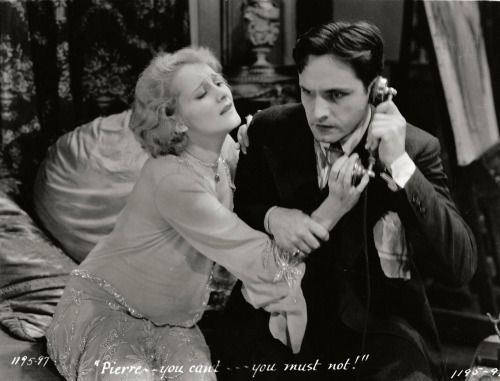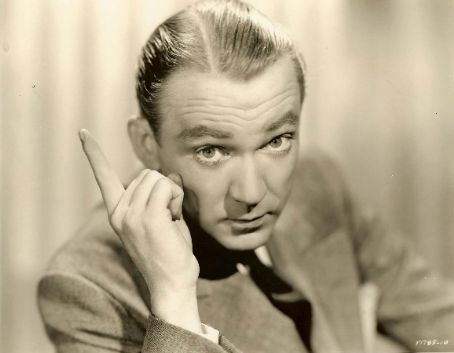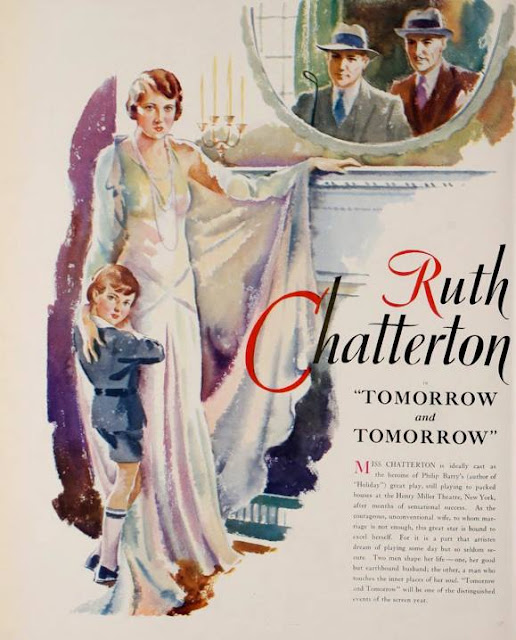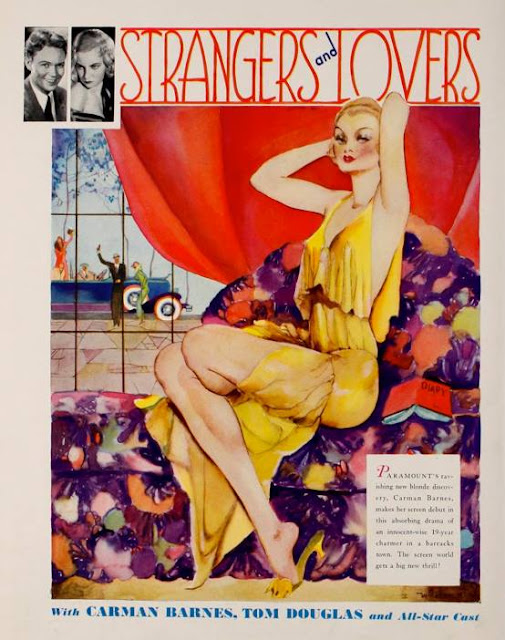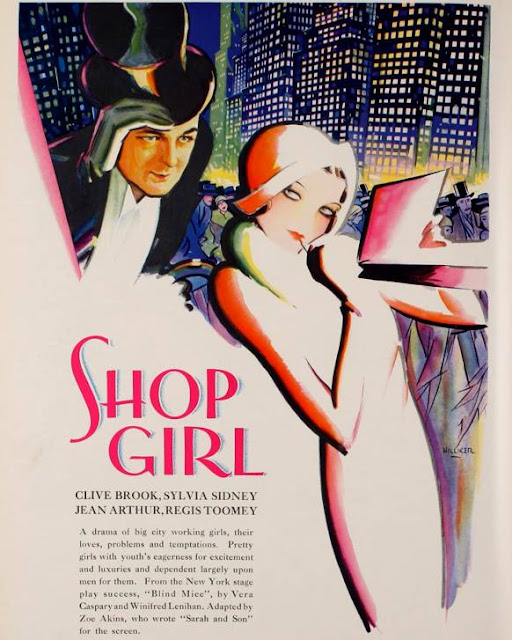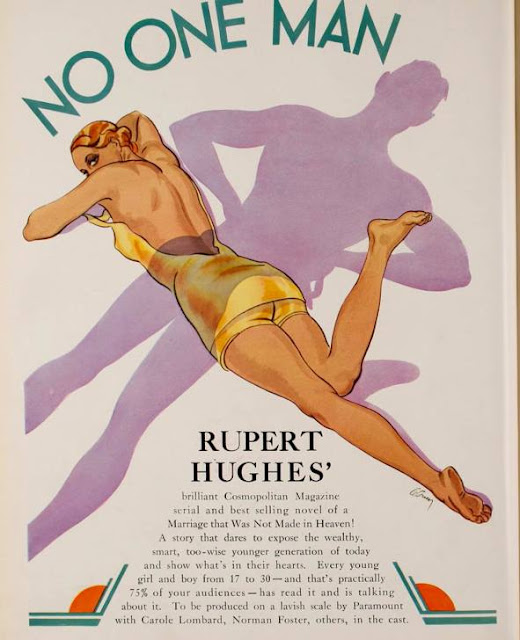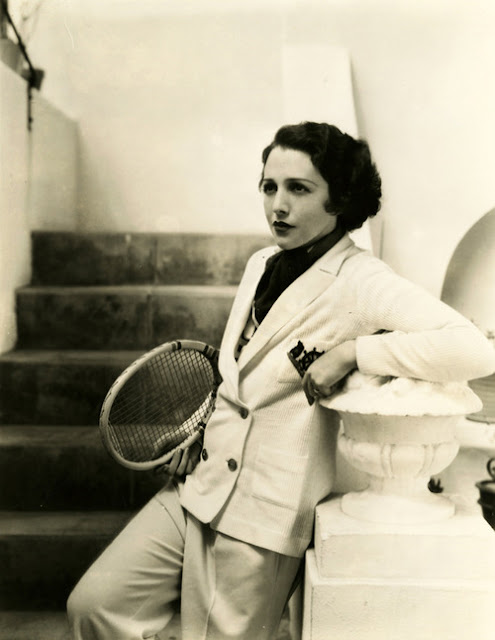Despite any inference or inclusion of LGBT people or 'sex perversion' - as it was called - being a fundamental no-no in the 1930 Motion Picture Production Code, Precode films are full of references to gay, lesbian, bisexual and transsexual people both to increase dramatic tension and for comedic effect. Whether as a 'sissy' or the stereotypical 'butch woman', several actors made a living out of playing these roles. Below is my A to Z of the best and worst of Precode LGBT:
A - Arthur, Johnny
A pretty and over-the-top actor, Johnny Arthur, took a break from his long term stage career to feature in films. With the coming of sound, Arthur was developed into a supportive, comedic relief character playing mostly overt homosexuals, 'pansies' or ultra-posh salesmen. He appeared in 26 Precode era films including the infamous lost movie, Convention City (1933). His best Precode appearances include in The Desert Song(1929), She Couldn't Say No (1930) and Penrod and Sam (1931). Arthur's quality and quantity or films decreased at the beginning of the war and never fully recovered. His 'pansy' typecast also technically became banned post-1934 but Arthur succeeded into more 'wimpy', 'weak' characters. He passed away, aged 68 on December 31, 1958. Despite acting in film for almost 30-years, there was no money in Arthur's estate for a proper burial and he grave was left unmarked until November 2012.
B - Boys will be boys
Wonder Bar(1934) is filled with bags of controversy. Between the black-face musical scenes, adultery, innuendo and countless double entendres, murder without getting caught and even the main character seeming cajoling a man to commit suicide so he could dump a dead body in his car, it is pretty shocking. Therefore, it is not surprising, the film caught the eye of production code administrators. Despite these elements, the film is mostly talked about today because of its illusion to homosexuals (a banned subject at the time) through an interesting dance scene. A handsome man asks a dancing couple if he could cut in. The female partner, expecting his attention, agrees, only to see him dance with her male partner. The main character, played by Al Jolson, then flaps his wrist and says, "Boys will be boys! Woo!"
C - Call her Savage
Clara Bow's 1932 film Call Her Savage is one of those shocking Precode movies which even modern audiences might find cringe worthy. Featuring countless 'forbidden' topics including rape, mixed race relationships, swearing, alcoholism, prostitution, adultery and not to mention the tragic death of a new born baby living in poverty, this film has everything. Slotted in between scenes of craziness is one including two clearly gay waiters dressed as French maids dancing and singing in what appears to be a gay bar. The two men appear to be having a great time singing about the pleasures of sailors in pajamas and so is the audience.
D - Dietrich
Marlene Dietrich's performance as Amy Jolly in Morocco (1930) proved that the fierce, blonde diva could get away with pretty much anything in the eyes of Precode audiences. I am referring to the scene where Dietrich performs "Quand l'amour Meurt" or "When Love Dies" at a nightclub. Dressed in a top hat and tails (see Vests, pants and ties below), she proceeds to sing the song before taking a flower from the hair of a woman in the audience then playfully kissing her on the mouth. No one appears to question her actions and she is even applauded. This scene is the only hint at Dietrich's bisexually in the film with the plot essentially a love story between Dietrich and Gary Cooper.
E - Effeminate
Effeminate is just one term used to describe the not-spoken-but-obvious homosexual character. Other terms included - pansy, sissy, fairy, nannie, fruit, queer and queen. They were clearly portrayed with everything from their costume to manner to the actors that played them pointing to their homosexuality. Richard Barrios book 'Screened Out' described the stereotype as:
"The fedora hat, the gestures that alternatively swept and minced, the little mustachio, the flower in the lapel - the pansy was as immediately recognisable on screen as he was in the urban sidestreets."
F - Frederici, Blanche
At age 42, Blanche Frederici, was older than most actresses who appeared on film for the first time. Frederici was known for playing mostly stern, masculine and uptight women in her Precode era films. She was often typecast as an older governess, nurse or unhappy wife. Frederici is mostly known for her role of a housekeeper in Night Nurse (1931), a chaperone in Flying Down to Rio (1933) and as a motel' owner's wife in her last film, It Happened One Night (1934). She died suddenly and unexpectedly, aged just 55, of a heart attack on December 23, 1933.
G - Girl Crazy (1932) ect.
![]()
I am using the letter 'G' to refer to the crazy collection of Precode Wheeler and Woosley films. You can't refer to just one when talking about references to the LGBT community because all of their films seem to question the true on-screen sexuality of the pair whilst intermingling them with a seemingly endless supply of barely clothed (sometimes actually naked) women. The duo made 21 pictures together with Peach O'Reno (1931), Diplomaniacs (1934), and Hips Hips Hooray(1934) and Girl Crazy (1932) their best films. Unfortunately I don't have enough room to mention all the suspect scenes in W & W's films, but believe me they included everything from the 'sissy' roles to sleeping in the same bed (Diplomaniacs) to double entendres and male to female cross-dressing (Peach-O-Reno). W & W were a strange combination, sometimes appearing as the homosexual for laughs but always getting a girl before the closing credits. Still, despite the happy 'straight' ending the pair never parted company to start separate lives. W & W also can't seem to go through a film without kissing each other. For example in Hip Hips Hooray the duo have a smooch with Wheeler commenting that Woolsey taste like "“lavender and old lace!". But don't take my word for it, some of W & W films are unbelievable, check them out. H - Haines
Actor, William Haines, was the poster boy for homosexual film stars in the 1930's. Extremely popular and handsome leading man, Haines, refused head of MGM, Louis B. Mayer's request to deny his sexuality and relationship with long term partner, Jimmie Shields, for a sham or 'lavender' marriage. He was subsequently fired by MGM and appeared in only a handful of films before retiring from acting in 1935. Not discouraged, Haines went on to begin a successful interior design business with Shields and had such illustrious clients as Joan Crawford, Gloria Swanson and Marion Davies. Haines most popular Precode films include Remote Control (1930), Fast Life (1932) and The Girl Said No (1930). Haines died aged 73 of lung cancer on December 26, 1973. Tragically, Shields took an overdose of sleeping pills shortly after.
**(I acknowledge this article is not nearly enough about Haines amazing life, career and LGBT advocacy, for more information go to his official business website on http://www.williamhaines.com)
I - Imagine, Just
The odd science fiction/ comedy/ musical film Just Imagine (1930) starring El Brendel and Maureen O'Sullivan raised the eyebrows of viewers and movie executives because of it's clear references to homosexuality. The questionable content centred on Ivan Linow's character, Boko. Linow play's Boko as a clear homosexual despite being a large, muscular 'bodyguard' type. As Boko and Queen of Mars, Looloo (Jozelle Joyner) meet El Brendel and his team, Brendel remarks, "She's not the queen - he is!" This is relating to Boko's smiles and advances towards Brendel's male group members. The censors were understandably not happy with this comment. J - Jozelle Joyner
Despite appearing in several noteworthy films, Joyzelle Joyner, will always be known for her performance as Ancaria in The Sign of the Cross (1932). In a scene where male lead, Fredric March, is trying to taunt orthodox Christian, Mercia (played by Elissa Landis), he orders Joyner to perform an erotic dance against Landis called the 'Dance of the Naked Moon'. March comments that he wants Joyner to "warm her into life". Although, the scene was pivotal to the relationship of March and Landis who (sorry for ruining the ending) get quite close as the film progresses, it is also interesting to see how the director deals with obviously lesbian themes.
K - Kissing
I am using this heading to refer to the famous and controversial scene between Christina (played by Greta Garbo) and her lady-in-waiting Countess Ebba Spare (Elizabeth Young) in Queen Christina (1933). It is the scene which involves the women talking about when they will see each other with Christina promising to take Ebba away for “two or three days”. She then kisses her lady-in-waiting on the mouth. As anyone can imagine, the scene caused outrage from the censors and religious groups, more so because it was passed and was allowed to be viewed by the general public.
L - Ladies They Talk About
Like most film depictions of female prison environments, Ladies They Talk About(1933) included its fair share of insinuations of lesbians and lesbian relationships. Featured mainly as old, serious, butch women, the 'lesbian' characterisations are a great source of threat for Barbara Stanwyck's character, Nan Taylor. As the "new fish", Taylor must negotiate her way around the ladies, "who like to wrestle". The 'wrestling' woman is pictured as a masculine person, smoking a cigar and, in one scene, doing weighs. In this film lesbians are seen as a negative, harmful presence rather than homosexual characters which are used for laughs.
M - Mädchen in Uniform
Although not strictly Precode because it was made under German filmmaking laws and regulations, Madchen in Uniform (1931) is still an iconic lesbian film from the early 1930's. The film was almost banned in the United States but was granted limited release in late 1932. Madchen in Uniform details a relationship between boarding school student, Manuela von Meinhardis (Hertha Thiele) and compassionate school teacher, Fräulein von Bernburg (Dorothea Wieck). The films shows nothing more explicit than a quick kiss between Wieck and Thiele, but overall deals with a forbidden love between a teacher and student. The themes of the movie are extremely modern and, as it featured an all-female cast, appealed to many lesbian and feminist audiences at the time.
N - Night After Night
Night After Night(1932) is a much overlooked drama film starring George Raft and Constance Cummings as well as featuring a spectacular debut film performance of Mae West. While it is often talked about in relation to West's screen career, I was shocked and surprised by several early scenes in the film. When the audience is shown Raft, he is sitting up in bed with his secretary, played by Roscoe Karns by his side. A short time later he gets up to have his daily morning bath and takes off his clothes. The audience is then shown more skin than any showgirl in a Busby Berkley musical as he bends to enter the bath. Karns remains present the entire time and even takes orders while Raft is bathing. Karns devotion and connection to Raft is continued throughout the film when he appears to give up his own life and comfort to help Raft.
O - Our Betters
When talking about the film, Our Betters (1933) you can't not mention the overtly gay character Earnest, played by character actor, Tyrell Davis. Generally included as a play for laughs, Davis embodies that typical over-the-top effeminate, homosexual stereotype. However, in this role the archetype is presented positively and, as Earnest, Davis saves the day by reuniting the two female leads by the use of some tango dance lessons. Several critics denounce his character as a disgusting gay stereotype, however, others see him as a light-hearted influence on the film and a highlight in the drama filled plot. I prefer Eric Kuersten's presented in Acidemic:
"George Cukor--as few have before or since--really shows how the right gay male at the right time makes any party ten times better and Earnest's last act entry really kicks home the idea of a weekend party's hungover Sunday…This late arrival's lack of connection with last night's damage makes him like an embodiment of fresh starts and forgiveness as he just starts rearranging everyone's mood even as the butler's taking your bag out to the car. So who laughs last? Call Earnest a stereotype, but he's delightful and even gets the priceless closing line: "There's no finer sight in the world than.. two women of title, kissing each other!""
P - Pangborn, Franklin
![]()
A popular comedic choice in the 1930s and 1940s, Franklin Pangborn was another actor typecast in the common gay role as the fussy and nervous yet elegant and polite offsider. He was often in support of the leading player. Pangborn - like many comedic actors - had his start in short subjects, mainly for Sennett, Hal Roach, Universal, Columbia and Pathe. He appeared in around 35 feature films during the Precode and dozens of other short subjects. He was usually cast in the role of a clerk (often a hotel clerk), producer, butler or an assistant and usually walked into scenes to provide a quick and easy laugh. His main costars included popular comedians W.C. Fields and Harold Lloyd. Notable Precode appearances include in International House (1933), Professional Sweetheart (1933) and Design For Living (1933). Pangborn transitioned easily into television when film roles became scarce in the early '50s and appeared several times in the Red Skelton Show. He died on July 20, 1958 aged just 69 following cancer surgery.
Q - Queen Christina
Garbo's triumph Queen Christina (1933) is a great example of the LGBT community represented as a normal part existence without being used as a source of humour or horror. As the title role as Queen Christina, Garbo is neither female nor completely male as suggested in this quote from an article on the Alternative Film Guide:
"In fact, never before had the actress exuded as much mystery as in her complex, ethereal portrayal of the androgynous queen. Perhaps it was the character's all-encompassing – and unsettling – mix of “male” and “female” qualities that allowed the actress to manifest a transcendental form of romantic passion the likes of which have rarely been seen on screen. Or, dare I say, in life."
Garbo's androgynousness is expressed mainly through her appearance. She wears her hair short and straight and is shown in male clothing for most of the movie. Her propensity for sex, drinking and vulgar language are also shown as typical behaviours of males of the time. Similarly, Queen Christina openly refuses to marry by yelling, "I shall die a bachelor!" Another example of her masculine leanings. This is also continued by her casually yet overtly mouth kissing one of her ladies in waiting but I talked about that scene more under 'K'.
R - Rico
With the reintroduction of Precodes into the mainstream thanks to home video, Edward G. Robinson's performance as Rico in Little Caesar (1931) has drawn an interesting and new interpretation from general viewers and film critics alike. Mick LaSalle in his book 'Dangerous Men: Pre-code Hollywood and the Birth of the Modern Man'wrote of Robinson's character's apparent closeted homosexuality. He argued that this is evident though Rico's affinity for Jo (Douglas Fairbanks Jr), aversion for romantic relationships and contempt towards Jo's relationships with women. LaSalle said that the author of the book on which the film was based, W.R. Burnett, had wrote Rico as explicitly straight and was shocked at the final scripting.
S - Sex perversion
In the early 30's homosexuals were never referred to as thus nor as lesbians, gays or bisexuals. In popular cultural anything from pansy, fairy or butch were used to identify these kinds of characters. In legislation and the 1930 Hays Code, homosexuality was referred to as 'sex perversion'. The code stated that any mention of sexual perversion or "any inference to it is forbidden". Its staunch view was continued further into the document when referring to "impure love" which could refer to homosexual relationships as much as adulterous or threesome arrangements. The code wrote:
"In the case of impure love, the love which society has always regarded as wrong and which has been banned by divine law, the following are important:
1. Impure love must not be presented as attractive and beautiful.
2. It must not be the subject of comedy or farce, or treated as material for laughter.
3. It must not be presented in such a way to arouse passion or morbid curiosity on the part of the audience.
4. It must not be made to seem right and permissible.
5. It general, it must not be detailed in method and manner."
Especially in the area of "subject of comedy or farce", the code was completely ignored.
T - Tashman
![]()
I am using Lilyan Tashman as a key example of famous actors during the Precode period who has since been labelled as LGBT. Alongside others, such as, Tashman's husband Edmund Lowe, Janet Gaynor, Greta Garbo, Marlene Dietrich, Cary Grant and Joan Crawford, Tashman's supposed sexuality has been discussed as truth in countless biographies and articles. Despite the fact that Tashman and others were entitled to a private life, there is nothing concrete to back up the claims. I have read that both Mary Brian, Irene Mayer Selznick and Lina Basquette have supposedly confirmed these rumours as true and, in fact, that Tashman hit on them. It is convenient, however, that none of these ladies are still living. Another biographer claimed columnist, Jimmy Starr, Tashman seduced actress Estelle Taylor. The main romance mentioned by biographers is one between Tashman and Greta Garbo. It is clear in early 1930 that the women were friends of some kind. Biographers claim journalists of the time used specific words and phrases to insinuate a ‘more than friendship’ relationship between the pair. These include exerts from magazines, such as:
"Lilyan Tashman shopping with Greta Garbo. No wonder our mystery woman has blossomed out with some swell duds lately. They make a neat pair."
"Lilyan Tashman sat opposite Greta. Greta whispered to the girl next to her, "Do I look like Lilyan?" The other girl answered, "Well, I admire you both but I don't think you look alike.""Oh, I am so sorry," Greta said. "They told me I looked like Lilyan and I did so want to be like her."
"Incidently, Garbo has a new girl friend - Fifi D'orsay, the Parisian paprika. Fifi is Garbo's first girl pal since she and Lilyan Tashman grew less friendly, some time back."
Mostly biographers and authors just quote others in the field. Most notably - according to one author - prolific historian, Anthony Slide wrote, "The better-known lesbians in Hollywood during the silent era include Evelyn Brent, Nita Naldi, Alla Nazimova and Lilyan Tashman".
I have probably gone on a massive tangent here; however, the overall point is the on-screen and off-screen behaviours of the Precode Hollywood LGBT community are usually analysed interchangeably or at least in the same sentence. While authors discuss some parts of film history as being based in fact, with most of the key players deceased, it near impossible to sort rumour from truth. With the case of Lilyan Tashman, many authors have looked to her screen roles (mainly Girls About Town 1931) and connected them to her real life sexual identity. All that we can know for sure is Tashman was legally married to Edmund Lowe from 1925 until her death in 1934. All evidence of her personal sexual preferences have stayed just that - personal and private.
U - Up like ladies
While women in drag was a serious business in Precode Hollwood, male actors dressed as women were strictly for laughs. Always a source of humour, male drag had been used since the silent era for easy comedic input. While Precode films continued that trend, early 1930's films did add that hint of seriousness by suggesting that the male character didn't dislike his transformation into a female as much as he should be societal standards. This also included characters unknowingly taking on typically female characteristics even when they were out of drag. An excellent example is Bert Wheeler's portrayal of a female love interest in comedy Peach-O-Reno (1931). Wheeler's women starts out being slapstick but he moulds into the female role as the film progresses even fighting for her man, Joe Bruno (Joseph Cawthorn).
V - Vests, pants and ties
Something strange occurred in the early 1930s. Possibly due to the devastation of the Great Depression or even the social problems that were still occurring post-World War I, an entirely new fashion started for androgynous dressing. Like everything, Precode films led the way, with Marlene Dietrich and Greta Garbo also forefronting the fashion trend. In her personal life as well as on camera, Dietrich was all about the suit. In films, such as, Blonde Venus (1932) and Morocco (1930), Dietrich performed musical numbers in suits typically worn by men. Other than these stars, male-type suits and other male outfits were typically worn by women when the director wanted to immediately brand the character as 'masculine', 'butch' or aggressive.
W - Watson, Bobby
Like most performers who played not-spoken-but-obviously 'homosexual' roles in Precode films, Bobby Watson, was officially classified as a character actor. He graduated from vaudeville and Broadway to appear in silent films in 1925. Watson only featured in countless films in the Precode era including Syncopation(1929), Moonlight and Pretzels (1933) and Going Hollywood (1933). Described as 'limp-wristed' and always featuring the typical lisp, Watson played a combination of weak husbands, designers, choreographers and other more effeminate jobs. He gained fame in the 1940s-60s playing Adolf Hitler, his comedic talents finally put to good use. Watson died on May 22, 1965 aged 77.
X - Xit Smiling
Admittedly, Exit Smiling (1926) is a silent film and is, therefore, not generally classified a Precode (but come on 'X' is not an easy letter to come up with a film for!). Despite this, it does mark the debut of Franklin Pangborn - mentioned above - as the appropriately named, Cecil Lovelace. It is a comedy film starring, Beatrice Lillie and Jack Pickford alongside Pangborn who, as always, plays the comic relief. Richard Barrios in 'Screened Out' describes Pangborn's Lovelace as a "one-man hissy fit" and as a nervous character, "with a certain frazzled dignity and an equivocal sexuality". According to Barrios, the film wasn't Pangborn's best but it was his first.
Y - Young As You Feel
Young As Your Feel(1931) is a B-grade comedy film directed by Frank Borzage and starring Will Rogers and Fifi D'Orsay. Its place on the list is due to one open and obvious display of clearly gay male characters. In a scene, the men are shown flirting with each other despite having female dates. It is a great example of how LGBT people can be featured as an ordinary part of society in some Precode films.
Z - Zzzz
Bedroom's themselves often provided a window into the real, but only ever hinted at, relationships of some characters. Often missed, a handful of Precode scenes show two male or two female characters sleeping in the same bed. Played mostly for laughs, Bert Wheeler and Robert Woolsey are often shown sleeping in the same bed or very close to each other. A scene in Diplomaniacs(1933) presents the pair almost cuddled up in the same double bed. Conversely, the small instances of females in the same bed are shown as a natural and normal part of the arrangement. In Millie(1931), Joan Blondell and Lilyan Tashman are always together and behave as a married couple. They are pictured in one scene as sleeping in the same bed. I don't know about you, but I think this duo are more than just friends.












